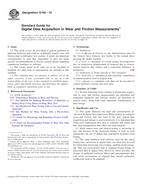We need your consent to use the individual data so that you can see information about your interests, among other things. Click "OK" to give your consent.
ASTM G163-10
Standard Guide for Digital Data Acquisition in Wear and Friction Measurements (Withdrawn 2016)
Automatically translated name:
Standard Guide for Digital Data Acquisition in Wear and Friction Measurements
STANDARD published on 1.4.2010
The information about the standard:
Designation standards: ASTM G163-10
Note: WITHDRAWN
Publication date standards: 1.4.2010
SKU: NS-57487
The number of pages: 3
Approximate weight : 9 g (0.02 lbs)
Country: American technical standard
Category: Technical standards ASTM
The category - similar standards:
Annotation of standard text ASTM G163-10 :
Keywords:
data acquisition, database, digital data, friction, hardware, software, tribology, wear, Digital data acquisition, Friction/frictional properties--metallic materials, Hardware, Data analysis--metals/alloys, Software, Tribology, Wear testing--metallic materials, ICS Number Code 19.060 (Mechanical testing)
Additional information
| Significance and Use | ||||||||||||
|
This guide illustrates the steps and considerations involved with digital data acquisition. While analog recording of wear and friction data has been in the past, digital data acquisition and storage is used extensively. It is important that DAQ users understand how data is collected and stored and how data manipulation may affect raw data integrity. Multi-station wear and friction testing is increasing in use, and because of the increased volume of data in such approaches, the use of digital data acquisition facilitates such testing. The same hardware and software used for the initial analog data conversion to digital form can often also be used for initial data processing, for example, multiple-point averaging. This can conveniently lead to computer-based storage of processed data in digital form. However, where possible, the storage of unfiltered (software filters) and unmanipulated data will allow reevaluation of original data should calibration coefficients need to be adjusted. Databases are frequently constructed in computerized format (see Guide G118) in order to hold large amounts of wear and friction data from laboratory test programs. |
||||||||||||
| 1. Scope | ||||||||||||
|
1.1 This guide covers the providing of general guidance in applying hardware and software to digitally acquire wear and friction data in laboratory test systems. It points out important considerations in such data acquisition. It does not make specific recommendations or discuss specific details regarding commercial hardware or software. 1.2 The values stated in SI units are to be regarded as standard. No other units of measurement are included in this standard. 1.3 This standard does not purport to address all of the safety concerns, if any, associated with its use. It is the responsibility of the user of this standard to establish appropriate safety and health practices and determine the applicability of regulatory limitations prior to use. |
||||||||||||
| 2. Referenced Documents | ||||||||||||
|
We recommend:
Technical standards updating
Do you want to make sure you use only the valid technical standards?
We can offer you a solution which will provide you a monthly overview concerning the updating of standards which you use.
Would you like to know more? Look at this page.




 Cookies
Cookies
